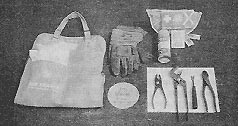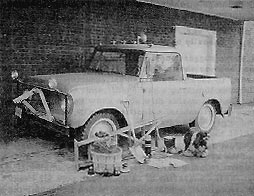The Handy Dandy (Amateur) Insulator Collector's Collecting Kit
by Sue Curtis Ducro
Reprinted from "INSULATORS - Crown Jewels of the Wire",, October 1970, page 3
In olden days it was always convenient to carry a beach bag in the car trunk
so as to never be unprepared for a possible swim in suitable weather.
Beach bags, like the versatile scouting knapsack, may now be converted into
Insulator's Readiness Bag.
Now, from reading about the ends to which some collectors go in their search
for more insulators, I classify them in the professional category, because it
must surely be a full time occupation as well as preoccupation. For these
specialists I would imagine that nothing less than a fully equipped lineman's
truck with a trailer extension for miner's equipment and electronic metal
detectors would be sufficient.
I can only speak for the amateur like myself who would secretly like to have
all (an more importantly, the time to go with it), but who of necessity has
tried to minimize the essential tools and settle for a compact carryall.
 Insulator Collecting Kit and
Contents Insulator Collecting Kit and
Contents
All containers such as tool chests, tackle boxes, old lunch pails, etc. were
eliminated in favor of a soft, pliable shoulder bag with a zipper and/or holdover
closure, preferably with extra outside pockets. These are available in the
attic, department stores, or surplus outlets. Their features serve several
discovered conveniences: 1) the necessary tools can be carried along
comfortably and altogether, without continually returning to the car: 2) a
shoulder strap or back harness frees both hands; 3) a secure but easily adjusted
closure prevents loss when stopping, bending, climbing, sliding down steep
banks, or slipping in the mud and small streams (sounds like work, doesn't it?);
4) soft but durable fabric such as canvas or soft leather is kind to the flesh
when bumped or when squeezing through narrow spaces. It is also light
weight.; 5) large enough (but not uncomfortably bulky or heavy) to hold a load
of insulators, inside or out, while scrambling from pole to pole or back to the
road with any lucky finds: 6) a carrying case holds the insulators while one is
removing them from a pole so that they are not dropped or broken by falling to
the ground or being thrown to a partner below.
The kit might contain the following tools and articles: 1) sturdy but
pliable gloves, preferable with leather palm for a firm grip when
twisting off the insulators (otherwise take a thin rubber hand-sized disk used
for twisting off bottle lids.); 2) pliers for turning bolts (to loosen
insulators and to salvage the attaching hardware or pins) and for pulling date
nails; 3) notched nail puller (long-handled for leverage) for
easily removing date nails; 4) strong wire cutters for removing
loose lines on the abandoned poles or insulators; 5) small first-aid kit
for minor scratches, splinters, insect bites, etc. (and don't forget the extra
precaution of keeping your tetanus boosters updated); 6) insect repellent;
7) sun cream and head covering; 8 & 9) your additional ideas.
 "Mobile Unit" with
insulator collecting materials. Canine mascot is optional. "Mobile Unit" with
insulator collecting materials. Canine mascot is optional.
Meanwhile, back at the car, the well-equipped insulator hunter will
have: 10) a long rope to throw over rotted pole arms or loose
insulators to avoid climbing; 11) binoculars (might save a trip after
some common or badly damaged ones); 12) ladders of varying lengths which
can really be carried conveniently only when you are on a specific hunting
expedition where you suspect they will be needed; 13) light weight baskets
to receive any treasure discovered; 14) digging tools if going to
a dump; 15) Thermos of water with extra paper cups and a box lunch (but
do not litter); 16) insulator identification books.
Comfortable attire consists of general hiking clothes with particular
consideration for: 17) long pants and high socks or shoes; (even in hot weather
unless assured of a clear location; a change of clothing is often practical for
unexpected weather change or dampness); 18) long-sleeved shirt or jacket and
head covering to prevent scratches and to protect from excessive sun or drizzle;
19) sturdy soles rubber boots (at least in the car) as old tracks and poles
always seem to be on the other side of the ditch or stream; 20) gloves as
described earlier.
A certain division of labor is only practical when "insulatoring"
in challenging locations. The most essential item for your checklist then
is one or more husky, agile young men to climb, carry, adjust ladder and
reconnoiter. This frees your expertise to navigate, instruct, and check
the catalog. This suggestion, unfortunately, is largely unattainable because,
first, such assistance is often unavailable and, secondly, it would take half
the fun away to not be in the very thick of things all the way along. (But
I would advise against "insulatoring" alone.
So, play it my ear. Play it prepared. But definitely play the
game. It's really very easy--on the lucky days!
(The above suggestions do not necessarily apply when collecting in shops or
at shows.)
| 